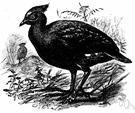Mound Builder
n.
1. Any of various distinct Native American cultures flourishing from around the 5th century bc to the 16th century ad especially in the Ohio and Mississippi Valleys, practicing settled agriculture and known for their often large burial, temple, or effigy mounds.
2. A member of a people associated with any of these cultures.
mound builder
n.
See megapode.
American Heritage® Dictionary of the English Language, Fifth Edition. Copyright © 2016 by Houghton Mifflin Harcourt Publishing Company. Published by Houghton Mifflin Harcourt Publishing Company. All rights reserved.
Mound Builder
n
1. (Archaeology) a member of a group of prehistoric inhabitants of the Mississippi region who built altar-mounds, tumuli, etc
2. (Peoples) a member of a group of prehistoric inhabitants of the Mississippi region who built altar-mounds, tumuli, etc
Collins English Dictionary – Complete and Unabridged, 12th Edition 2014 © HarperCollins Publishers 1991, 1994, 1998, 2000, 2003, 2006, 2007, 2009, 2011, 2014
ThesaurusAntonymsRelated WordsSynonymsLegend:
| Noun | 1. |  Mound Builder - prehistoric Amerindians who built altar mounds Mound Builder - prehistoric Amerindians who built altar moundsprimitive, primitive person - a person who belongs to an early stage of civilization |
| 2. |  mound builder - large-footed short-winged birds of Australasia; build mounds of decaying vegetation to incubate eggs mound builder - large-footed short-winged birds of Australasia; build mounds of decaying vegetation to incubate eggsgallinacean, gallinaceous bird - heavy-bodied largely ground-feeding domestic or game birds family Megapodiidae, Megapodiidae - megapodes leipoa, Leipoa ocellata, lowan, mallee fowl - Australian mound bird; incubates eggs naturally in sandy mounds Alectura lathami, brush turkey - black megapode of wooded regions of Australia and New Guinea Macrocephalon maleo, maleo - Celebes megapode that lays eggs in holes in sandy beaches |
Based on WordNet 3.0, Farlex clipart collection. © 2003-2012 Princeton University, Farlex Inc.